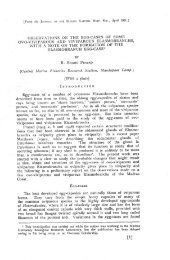PDF - Eprints@CMFRI
PDF - Eprints@CMFRI
PDF - Eprints@CMFRI
You also want an ePaper? Increase the reach of your titles
YUMPU automatically turns print PDFs into web optimized ePapers that Google loves.
107<br />
We have also studied KLUNZINGER 's type of Orbicella laxa from Koseir, 0. 2193 in Berlin Museum .<br />
Material :<br />
Gulf of Aqaba : Basel PW 71 354 (Fara'un lsI. , 40 m) ; 73 694 (EI Kura).<br />
orthern R. S.: HLM X2: 3- 19 ,22 (G uballsl.).<br />
Central R. S.: HLM EC 1379 (Djiddah).<br />
P. Sud . Sa 55 (Sanganeb R.).<br />
HLM RM 80 (Wingate R.) .<br />
Di strib ut ion: Red Sea ; Reunion ( FAURE, 1977) ; Great Barrier Reef; Solomon Isis. (PILLAI,<br />
STODDART & MORTON, unpubl.).<br />
R em ark s: STEPH ENSON & WELLS (1956) felt that F. laxa along with F. wakayana and F vacua<br />
could be synonyms of Plesiastrea versipora . The presence of extratentacular buds in Flaxa as pointed out<br />
by KLUNZINGER (1879) suggests its affinity to Plesiastrea. The possibility of F laxa being a geographical<br />
variant of P. versipora cannot be overlooked .<br />
MATTHAI 'S (1914) F. ananas is represented by one specimen ( BMN H 27 . 5. 12. 163) from Red Sea.<br />
It is about 58 mm in greater spread. Only 8 to 10 septa reach the columella and the septal edges have poorly<br />
developed teeth. MATTHAI adds that in F.allallas the asexual reproduction is by means of division, while<br />
in F laxa both division and gemmation occurs. It is very likely that this specimen may fall within the<br />
skeletal range of F. laxa.<br />
Favia<br />
Fa via helia11thoides WELLS , 1954<br />
(Plate 26, Figs. 9, 10)<br />
heliantboides 1954. WELLS, 458 i pI. 17412- 6 (Type locality : Bikini Atoll).<br />
1974. W1JSMAN·BEST. 257; pI. 413.<br />
1980, HEAD, 151 , 456.<br />
We have only one specimen before us, collected by Prof. SCHRO EDER at the Sanganeb Reef in a depth<br />
of about 15 m. It has a hi llocky growthform, about 70 mm high and with a diameter of 80 mm at the<br />
base. The corallites are nodular, elevated, and considerably far aparr. Diameter of coraUites 7 to 9 mm,<br />
diameter of the inner calices 3 to 4 mm. Septa 18 to 24 in number, all reach the columella and terminate<br />
in paliform lobes, formi ng a prominent crown. Margins of septa finely dentate. A second set of septa<br />
alternate with the principals and are very indistinct in the calices. Costae correspond to all septa and are<br />
equal in size and very regularly crenellate.<br />
Material:<br />
Central R. S. : P. Sud. Sa 64 (Sanganeb R., 10- 16 m).<br />
Dis t rib uti on: Red Sea; Molucca Sea ; Solomon Isis.; Marshall Isis.<br />
R emarks : A specimen from Solomon Islands was identified by one of us (PILLAI, in 1970) as<br />
F heliantboides, which was later sent to Dr. Maya WIjSMAN-BEST. She compared this with KLUNZINGER's<br />
type of Orbicel/a taxa (personal communication) and opined the Solomon specimen matches F laxa in<br />
every respecr. She merged these tWO species (WIjSMAN-BEST, 1972), but later separated them again (1974).<br />
Also VERON, PI CHON & WIj SMAN-BEST (1977) stated that F laxa and F. helianthoides are not synonymous<br />
with each other.<br />
Favia pal/ida (DANA) , 1846<br />
(Plate 27, Figs. I, 2)<br />
AstraeQ<br />
pallida<br />
pal/ida<br />
1846, DANA, 224; pI. 10/ 12 , 13a- e.<br />
1876, HAECKEL. 19; fig. 16 (: DANA, 1872 . figs. p. 64).<br />
1918. VAUGHAN. 105; pI. 38/1- 7 .<br />
1971 , CHEVALIE R, 105 ; pis. 10/ 1- 4 , 6 ,1; 13/ 4. So 14/1 - 3; 17 / 1. 2 .<br />
1972. WIjSMAN-BEST, 18 : pI. 213. 4 .<br />
1974, MERCNER & SCHUHMACHER, 264.<br />
1974, SCHEER & PILLAI, 45.<br />
15 Zon\ogica. 1 Jj
















